Observation of Near-Inertial Oscillation in an Anticyclonic Eddy in the Northern South China Sea
Abstract
1. Introduction
2. Data and Methods
2.1. Data
2.2. Methods
3. Results
3.1. An Anticyclonic Eddy
3.2. NIOs and Subharmonic Waves
4. Discussion and Conclusions
Author Contributions
Funding
Data Availability Statement
Conflicts of Interest
References
- Jochum, M.; Briegleb, B.P.; Danabasoglu, G.; Large, W.G.; Norton, N.J.; Jayne, S.R.; Alford, M.H.; Bryan, F.O. The Impact of Oceanic Near-Inertial Waves on Climate. J. Clim. 2013, 26, 2833–2844. [Google Scholar] [CrossRef]
- Alford, M.H.; MacKinnon, J.A.; Simmons, H.L.; Nash, J.D. Near-Inertial Internal Gravity Waves in the Ocean. Annu. Rev. Mar. Sci. 2016, 8, 95–123. [Google Scholar] [CrossRef] [PubMed]
- Li, Y.; Xu, Z.; Lv, X. The Generation and Propagation of Wind- and Tide-Induced Near-Inertial Waves in the Ocean. J. Mar. Sci. Eng. 2024, 12, 1565. [Google Scholar] [CrossRef]
- Gill, A.E. On the Behavior of Internal Waves in the Wakes of Storms. J. Phys. Oceanogr. 1984, 14, 1129–1151. [Google Scholar] [CrossRef]
- Moehlis, J.; Llewellyn Smith, S.G. Radiation of Mixed Layer Near-Inertial Oscillations into the Ocean Interior. J. Phys. Oceanogr. 2001, 31, 1550–1560. [Google Scholar] [CrossRef]
- Alford, M.H. Improved Global Maps and 54-year History of Wind-work on Ocean Inertial Motions. Geophys. Res. Lett. 2003, 30, 2002GL016614. [Google Scholar] [CrossRef]
- Jiang, J.; Lu, Y.; Perrie, W. Estimating the Energy Flux from the Wind to Ocean Inertial Motions: The Sensitivity to Surface Wind Fields. Geophys. Res. Lett. 2005, 32, 2005GL023289. [Google Scholar] [CrossRef]
- Rimac, A.; von Storch, J.-S.; Eden, C.; Haak, H. The Influence of High-Resolution Wind Stress Field on the Power Input to near-Inertial Motions in the Ocean. Geophys. Res. Lett. 2013, 40, 4882–4886. [Google Scholar] [CrossRef]
- Egbert, G.D.; Erofeeva, S.Y. Efficient Inverse Modeling of Barotropic Ocean Tides. J. Atmos. Oceanic Technol. 2002, 19, 183–204. [Google Scholar] [CrossRef]
- Mooers, C.N.K. Several Effects of a Baroclinic Current on the Cross-stream Propagation of Inertial-internal Waves. Geophys. Astrophys. Fluid Dyn. 1975, 6, 245–275. [Google Scholar] [CrossRef]
- Kunze, E. Near-Inertial Wave Propagation in Geostrophic Shear. J. Phys. Oceanogr. 1985, 15, 544–565. [Google Scholar] [CrossRef]
- D’Asaro, E.A. The Decay of Wind-forced Mixed Layer Inertial Oscillations Due to the β Effect. J. Geophys. Res. 1989, 94, 2045–2056. [Google Scholar] [CrossRef]
- Garrett, C. What Is the “Near-Inertial” Band and Why Is It Different from the Rest of the Internal Wave Spectrum? J. Phys. Oceanogr. 2001, 31, 962–971. [Google Scholar] [CrossRef]
- Thomas, L.N.; Rainville, L.; Asselin, O.; Young, W.R.; Girton, J.; Whalen, C.B.; Centurioni, L.; Hormann, V. Direct Observations of Near-Inertial Wave ζ-Refraction in a Dipole Vortex. Geophys. Res. Lett. 2020, 47, e2020GL090375. [Google Scholar] [CrossRef]
- Asselin, O.; Young, W.R. Penetration of Wind-Generated Near-Inertial Waves into a Turbulent Ocean. J. Phys. Oceanogr. 2020, 50, 1699–1716. [Google Scholar] [CrossRef]
- Lee, D.; Niiler, P.P. The Inertial Chimney: The Near-inertial Energy Drainage from the Ocean Surface to the Deep Layer. J. Geophys. Res. 1998, 103, 7579–7591. [Google Scholar] [CrossRef]
- Zhai, X.; Greatbatch, R.J.; Zhao, J. Enhanced Vertical Propagation of Storm-induced Near-inertial Energy in an Eddying Ocean Channel Model. Geophys. Res. Lett. 2005, 32, 2005GL023643. [Google Scholar] [CrossRef]
- Joyce, T.M.; Toole, J.M.; Klein, P.; Thomas, L.N. A Near-inertial Mode Observed within a Gulf Stream Warm-core Ring. J. Geophys. Res. Oceans 2013, 118, 1797–1806. [Google Scholar] [CrossRef]
- Whitt, D.B.; Thomas, L.N. Near-Inertial Waves in Strongly Baroclinic Currents. J. Phys. Oceanogr. 2013, 43, 706–725. [Google Scholar] [CrossRef]
- Danioux, E.; Vanneste, J.; Bühler, O. On the Concentration of Near-Inertial Waves in Anticyclones. J. Fluid Mech. 2015, 773, R2. [Google Scholar] [CrossRef]
- Alford, M.H.; Whitmont, M. Seasonal and Spatial Variability of Near-Inertial Kinetic Energy from Historical Moored Velocity Records. J. Phys. Oceanogr. 2007, 37, 2022–2037. [Google Scholar] [CrossRef]
- Yu, X.; Naveira Garabato, A.C.; Vic, C.; Gula, J.; Savage, A.C.; Wang, J.; Waterhouse, A.F.; MacKinnon, J.A. Observed Equatorward Propagation and Chimney Effect of Near-Inertial Waves in the Midlatitude Ocean. Geophys. Res. Lett. 2022, 49, e2022GL098522. [Google Scholar] [CrossRef]
- Li, Q.; Chen, Z.; Guan, S.; Yang, H.; Jing, Z.; Liu, Y.; Sun, B.; Wu, L. Enhanced Near-Inertial Waves and Turbulent Diapycnal Mixing Observed in a Cold- and Warm-Core Eddy in the Kuroshio Extension Region. J. Phys. Oceanogr. 2022, 52, 1849–1866. [Google Scholar] [CrossRef]
- Martínez-Marrero, A.; Barceló-Llull, B.; Pallàs-Sanz, E.; Aguiar-González, B.; Estrada-Allis, S.N.; Gordo, C.; Grisolía, D.; Rodríguez-Santana, A.; Arístegui, J. Near-Inertial Wave Trapping Near the Base of an Anticyclonic Mesoscale Eddy Under Normal Atmospheric Conditions. J. Geophys. Res. Oceans 2019, 124, 8455–8467. [Google Scholar] [CrossRef]
- Kunze, E.; Schmitt, R.W.; Toole, J.M. The Energy Balance in a Warm-Core Ring’s Near-Inertial Critical Layer. J. Phys. Oceanogr. 1995, 25, 942–957. [Google Scholar] [CrossRef]
- Simmons, H.L. Spectral Modification and Geographic Redistribution of the Semi-Diurnal Internal Tide. Ocean Modell. 2008, 21, 126–138. [Google Scholar] [CrossRef]
- Xing, J.; Davies, A.M. Processes Influencing the Non-linear Interaction between Inertial Oscillations, Near Inertial Internal Waves and Internal Tides. Geophys. Res. Lett. 2002, 29, 11-1–11-4. [Google Scholar] [CrossRef]
- Chen, G.; Hou, Y.; Chu, X.; Qi, P. Vertical Structure and Evolution of the Luzon Warm Eddy. Chin. J. Ocean. Limnol. 2010, 28, 955–961. [Google Scholar] [CrossRef]
- Chu, X.; Xue, H.; Qi, Y.; Chen, G.; Mao, Q.; Wang, D.; Chai, F. An Exceptional Anticyclonic Eddy in the South China Sea in 2010. JGR Oceans 2014, 119, 881–897. [Google Scholar] [CrossRef]
- Wang, D.; Xu, H.; Lin, J.; Hu, J. Anticyclonic Eddies in the Northeastern South China Sea during Winter 2003/2004. J. Oceanogr. 2008, 64, 925–935. [Google Scholar] [CrossRef]
- Zhang, Z.; Zhao, W.; Qiu, B.; Tian, J. Anticyclonic Eddy Sheddings from Kuroshio Loop and the Accompanying Cyclonic Eddy in the Northeastern South China Sea. J. Phys. Oceanogr. 2017, 47, 1243–1259. [Google Scholar] [CrossRef]
- Li, L.; Nowlin, W.D.; Jilan, S. Anticyclonic Rings from the Kuroshio in the South China Sea. Deep Sea Res. Part I Oceanogr. Res. Pap. 1998, 45, 1469–1482. [Google Scholar] [CrossRef]
- Li, B.; Du, L.; Peng, S.; Yuan, Y.; Meng, X.; Lv, X. Modulation of Internal Tides by Turbulent Mixing in the South China Sea. Front. Mar. Sci. 2021, 8, 772979. [Google Scholar] [CrossRef]
- Wang, W.; Li, J.; Huang, X. Semidiurnal Internal Tide Interference in the Northern South China Sea. J. Mar. Sci. Eng. 2024, 12, 811. [Google Scholar] [CrossRef]
- Chen, G.; Hou, Y.; Chu, X. Mesoscale Eddies in the South China Sea: Mean Properties, Spatiotemporal Variability, and Impact on Thermohaline Structure. J. Geophys. Res. 2011, 116, C06018. [Google Scholar] [CrossRef]
- Lin, F.; Zhu, L.; Zhou, B.; Ding, T.; Jin, W.; Liang, C. Observations of Strong Near-Inertial Currents Induced by the Reflection of Tropical Cyclone-Induced Near-Inertial Waves on the Continental Slope of the Northern South China Sea. Deep Sea Res. Part I Oceanogr. Res. Pap. 2022, 190, 103893. [Google Scholar] [CrossRef]
- Liu, J.; He, Y.; Li, J.; Cai, S.; Wang, D.; Huang, Y. Cases Study of Nonlinear Interaction Between Near-Inertial Waves Induced by Typhoon and Diurnal Tides Near the Xisha Islands. J. Geophys. Res. Oceans 2018, 123, 2768–2784. [Google Scholar] [CrossRef]
- Guan, S.; Zhao, W.; Huthnance, J.; Tian, J.; Wang, J. Observed Upper Ocean Response to Typhoon Megi (2010) in the Northern South China Sea. J. Geophys. Res. Oceans 2014, 119, 3134–3157. [Google Scholar] [CrossRef]
- Xu, X.; Zhao, W.; Huang, X.; Hu, Q.; Guan, S.; Zhou, C.; Tian, J. Observed Near-Inertial Waves Trapped in a Propagating Anticyclonic Eddy. J. Phys. Oceanogr. 2022, 52, 2029–2047. [Google Scholar] [CrossRef]
- Gonella, J. A Rotary-Component Method for Analysing Meteorological and Oceanographic Vector Time Series. Deep Sea Res. Abstr. 1972, 19, 833–846. [Google Scholar] [CrossRef]
- Alford, M.H.; Gregg, M.C. Near-inertial Mixing: Modulation of Shear, Strain and Microstructure at Low Latitude. J. Geophys. Res. 2001, 106, 16947–16968. [Google Scholar] [CrossRef]
- Leaman, K.D. Observations on the Vertical Polarization and Energy Flux of Near-Inertial Waves. J. Phys. Oceanogr. 1976, 6, 894–908. [Google Scholar] [CrossRef]
- Xie, X.; Chen, G.; Shang, X.; Fang, W. Evolution of the Semidiurnal (M2) Internal Tide on the Continental Slope of the Northern South China Sea. Geophys. Res. Lett. 2008, 35, 2008GL034179. [Google Scholar] [CrossRef]
- Xie, X.; Shang, X.; Van Haren, H.; Chen, G. Observations of Enhanced Nonlinear Instability in the Surface Reflection of Internal Tides. Geophys. Res. Lett. 2013, 40, 1580–1586. [Google Scholar] [CrossRef]
- Young, W.R.; Jelloul, M.B. Propagation of Near-Inertial Oscillations through a Geostrophic Flow. J. Mar. Res. 1997, 55, 735–766. [Google Scholar] [CrossRef]
- Chen, G.; Xue, H.; Wang, D.; Xie, Q. Observed Near-Inertial Kinetic Energy in the Northwestern South China Sea. J. Geophys. Res. Oceans 2013, 118, 4965–4977. [Google Scholar] [CrossRef]
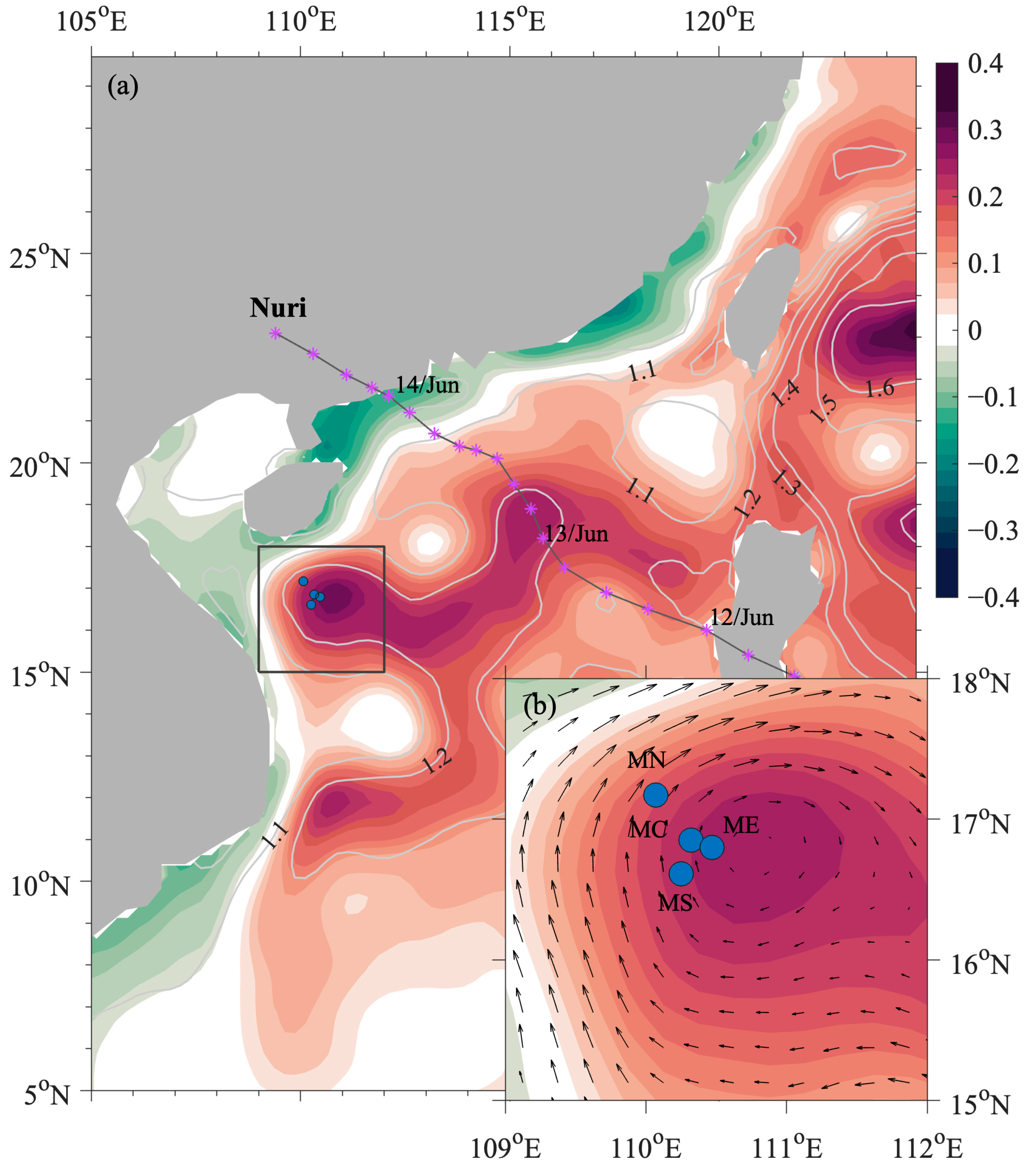
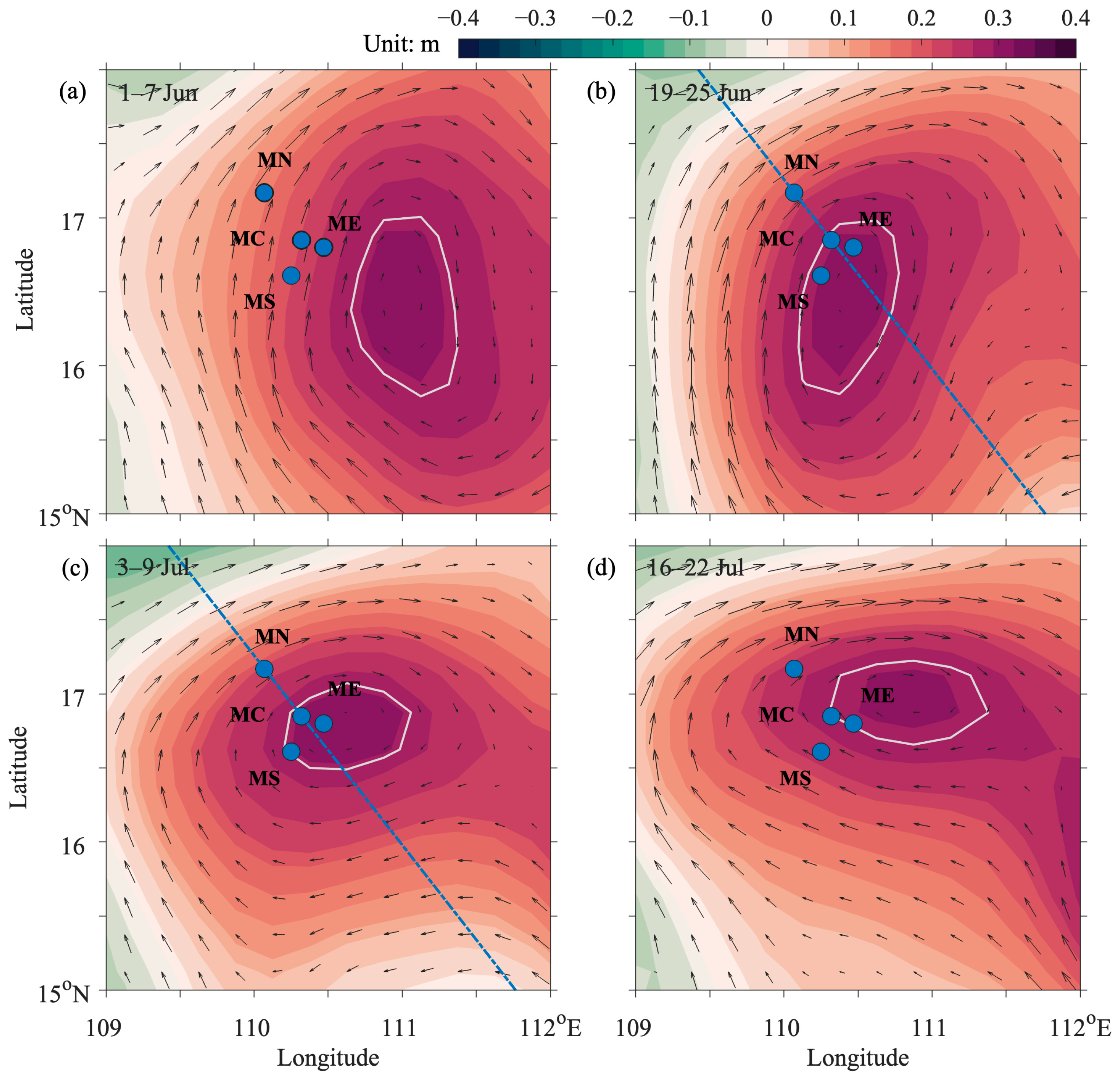
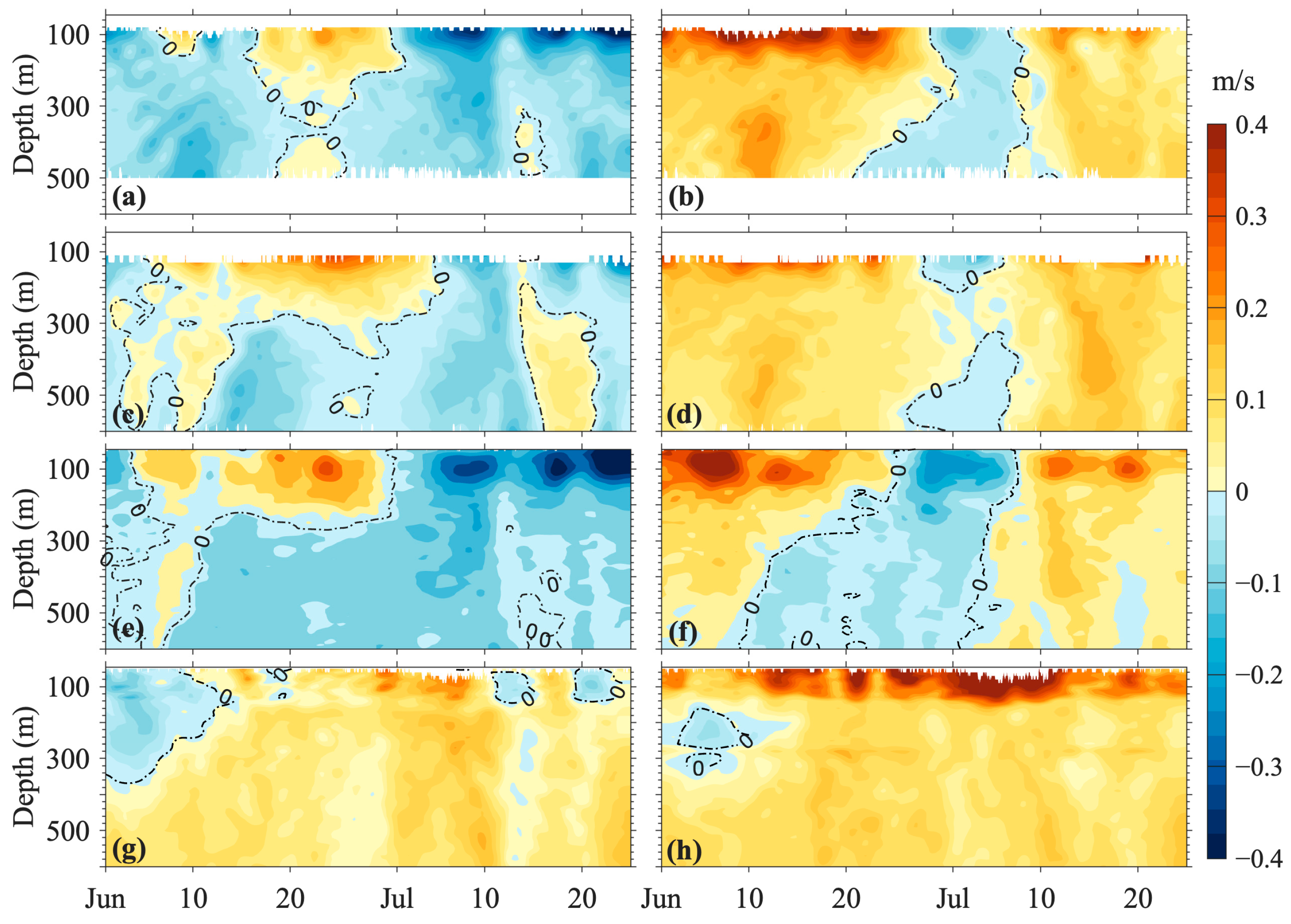

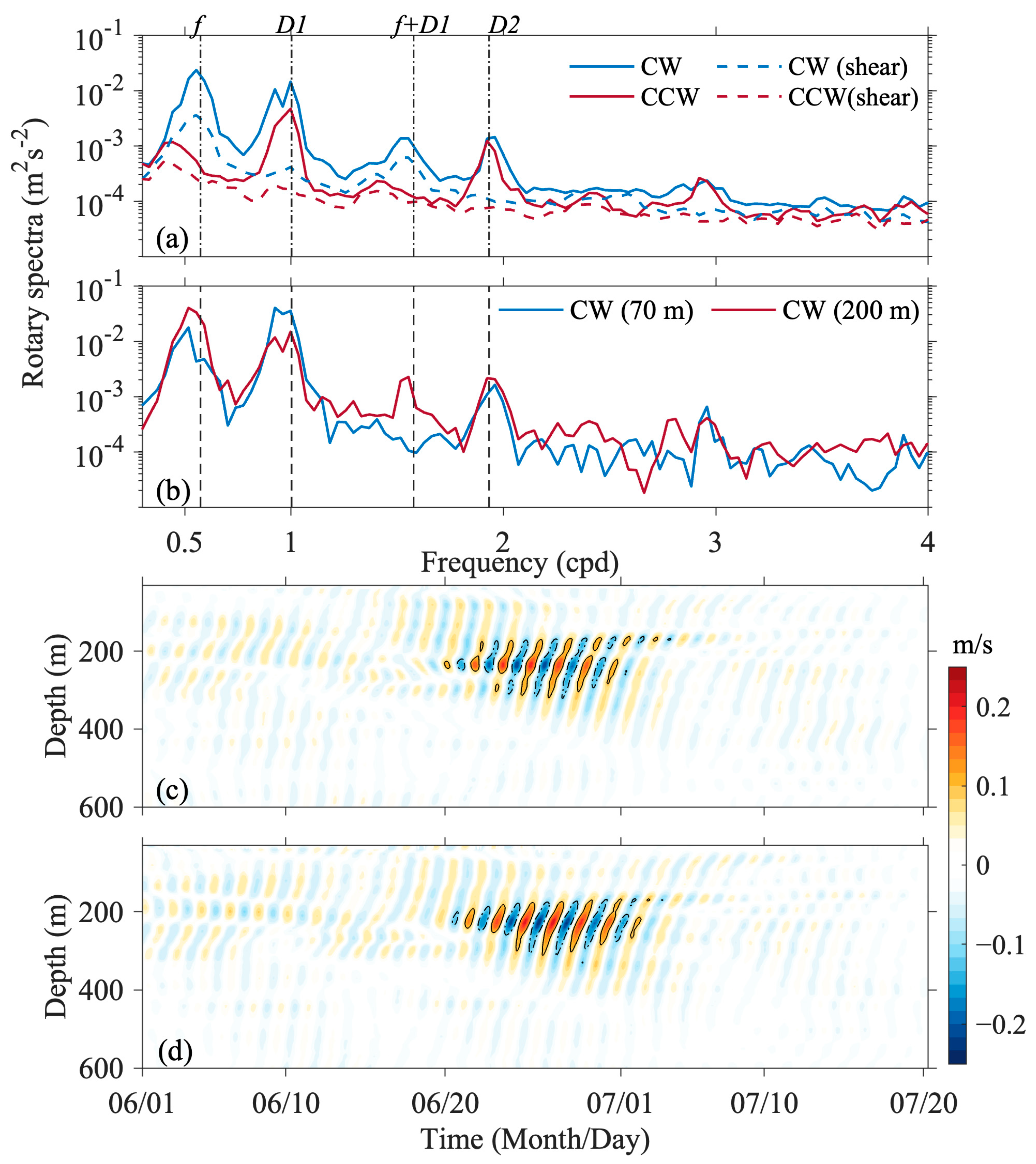
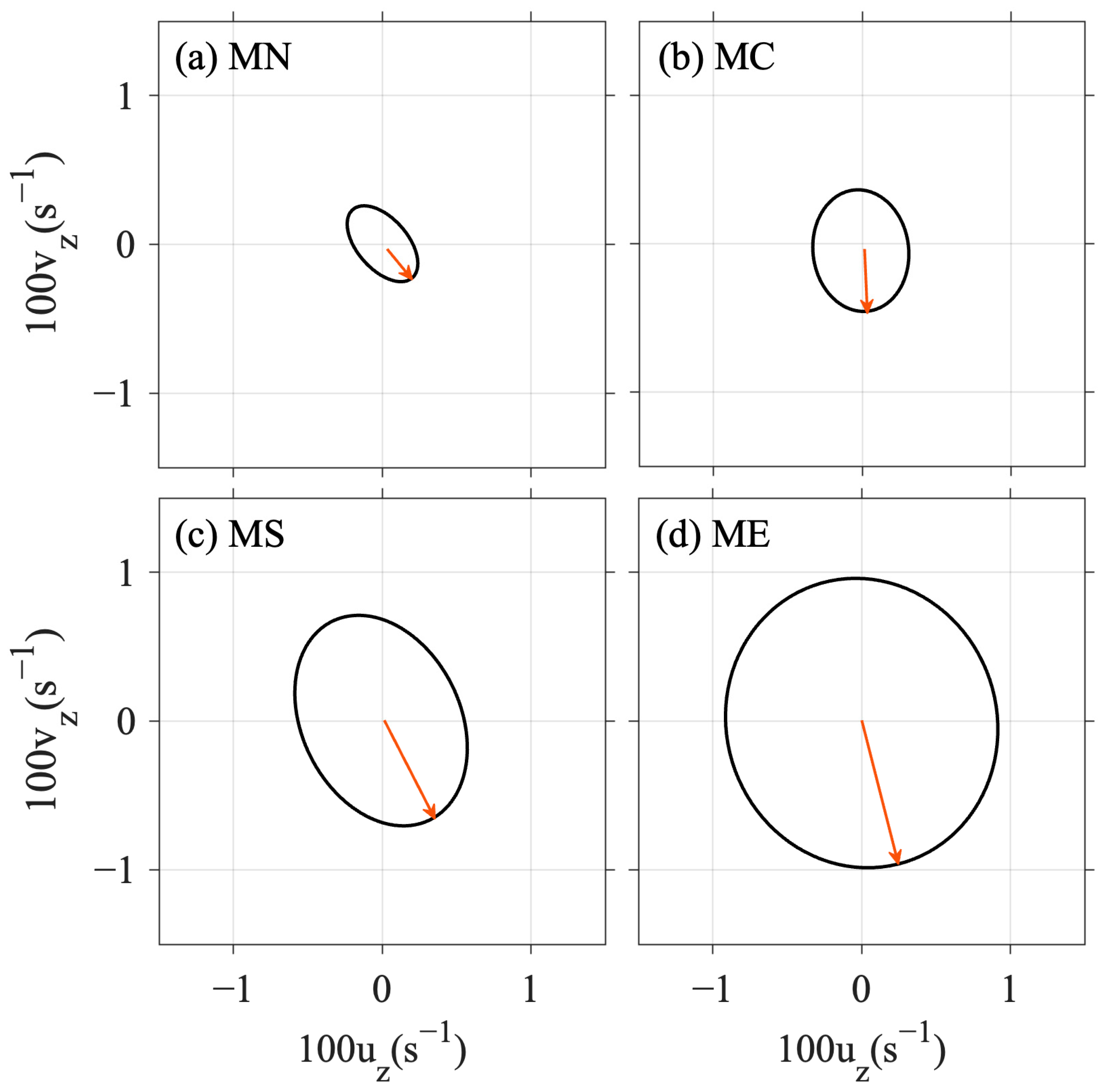
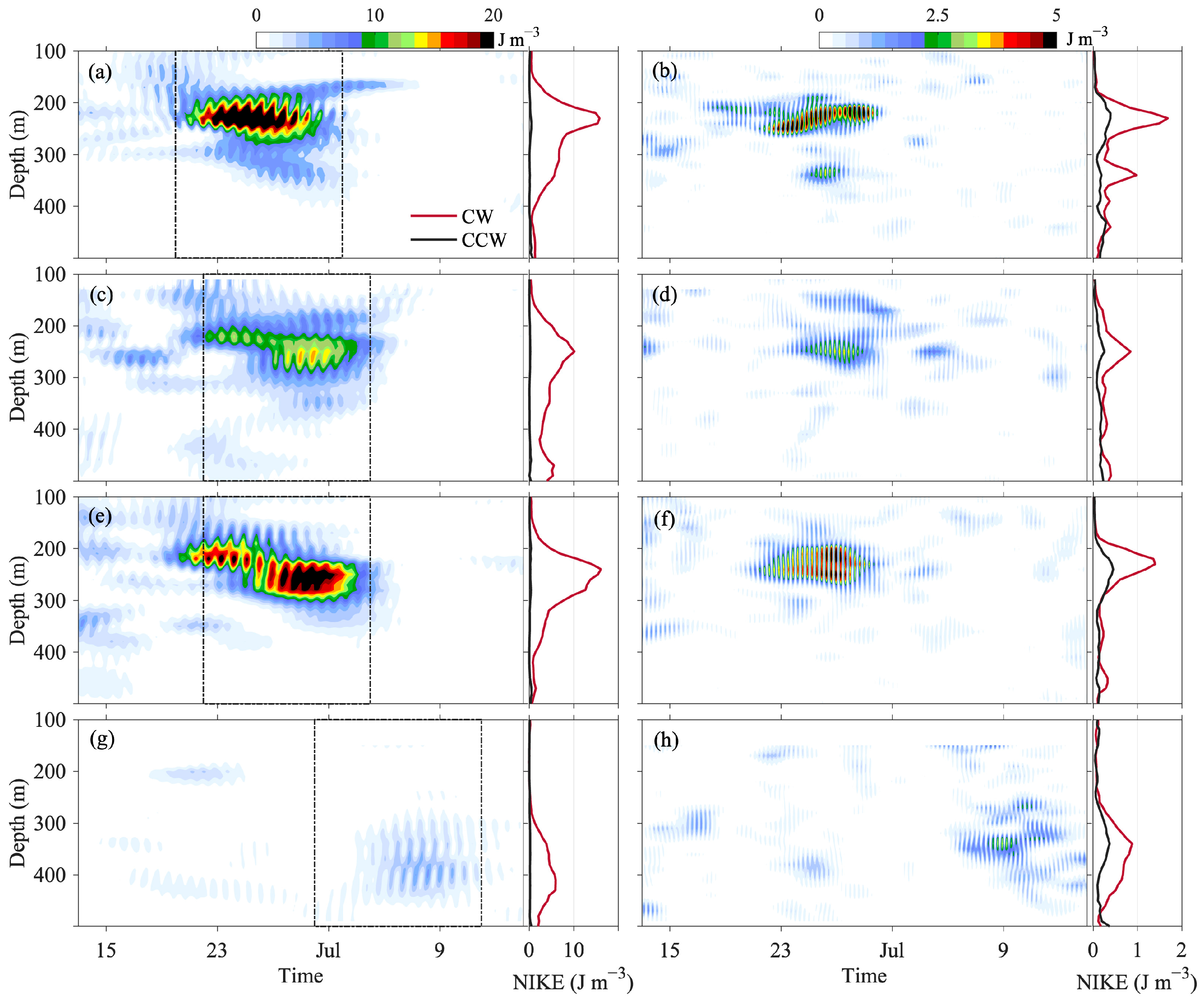
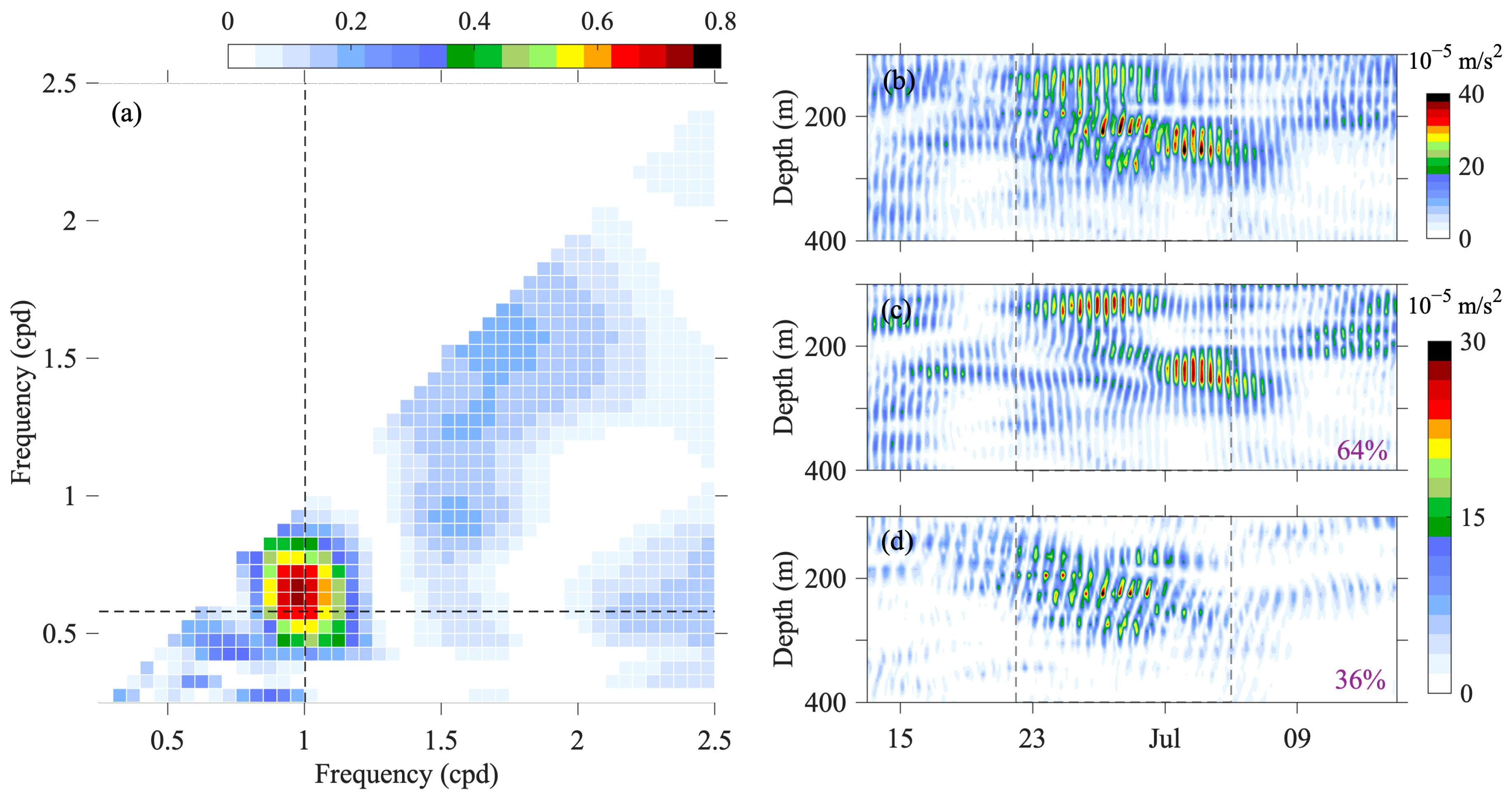
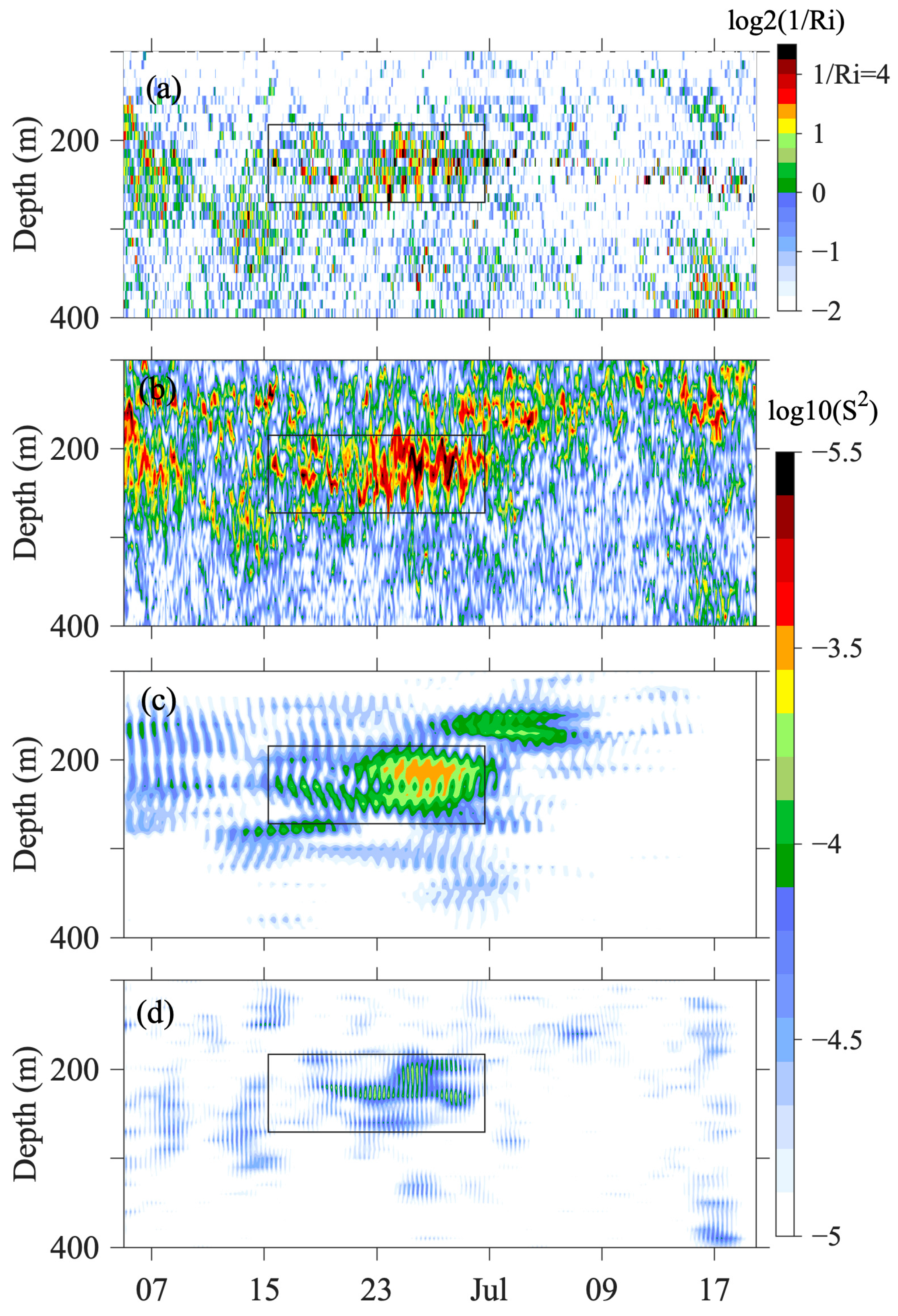
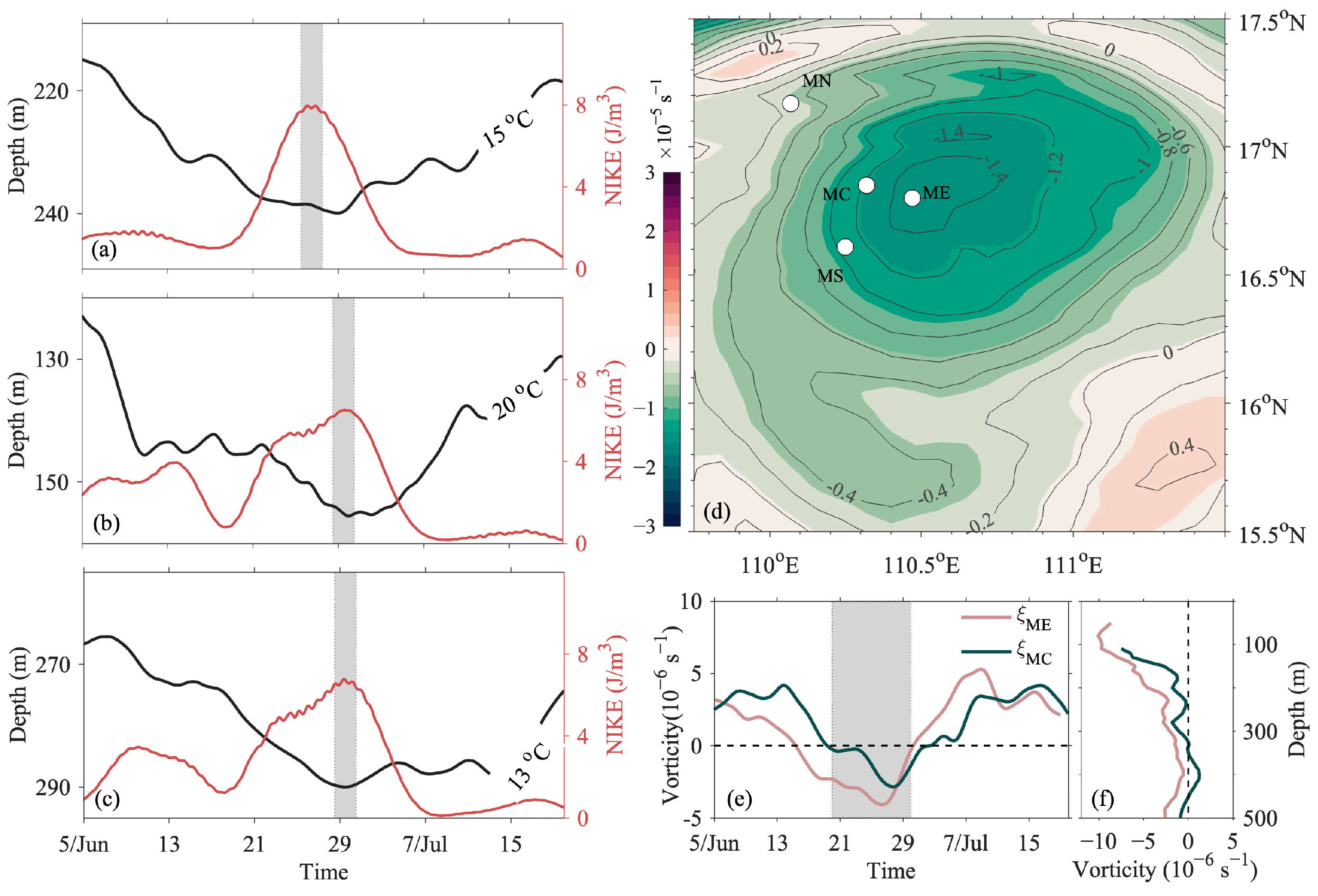
Disclaimer/Publisher’s Note: The statements, opinions and data contained in all publications are solely those of the individual author(s) and contributor(s) and not of MDPI and/or the editor(s). MDPI and/or the editor(s) disclaim responsibility for any injury to people or property resulting from any ideas, methods, instructions or products referred to in the content. |
© 2025 by the authors. Licensee MDPI, Basel, Switzerland. This article is an open access article distributed under the terms and conditions of the Creative Commons Attribution (CC BY) license (https://creativecommons.org/licenses/by/4.0/).
Share and Cite
Xie, B.; Liu, T.; Huang, B.; Liang, C.; Lin, F. Observation of Near-Inertial Oscillation in an Anticyclonic Eddy in the Northern South China Sea. J. Mar. Sci. Eng. 2025, 13, 1079. https://doi.org/10.3390/jmse13061079
Xie B, Liu T, Huang B, Liang C, Lin F. Observation of Near-Inertial Oscillation in an Anticyclonic Eddy in the Northern South China Sea. Journal of Marine Science and Engineering. 2025; 13(6):1079. https://doi.org/10.3390/jmse13061079
Chicago/Turabian StyleXie, Botao, Tao Liu, Bigui Huang, Chujin Liang, and Feilong Lin. 2025. "Observation of Near-Inertial Oscillation in an Anticyclonic Eddy in the Northern South China Sea" Journal of Marine Science and Engineering 13, no. 6: 1079. https://doi.org/10.3390/jmse13061079
APA StyleXie, B., Liu, T., Huang, B., Liang, C., & Lin, F. (2025). Observation of Near-Inertial Oscillation in an Anticyclonic Eddy in the Northern South China Sea. Journal of Marine Science and Engineering, 13(6), 1079. https://doi.org/10.3390/jmse13061079





